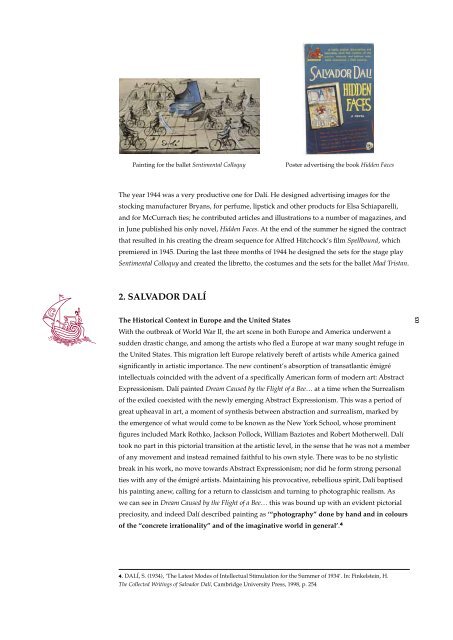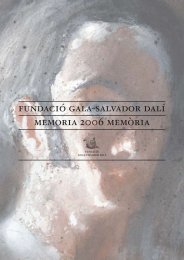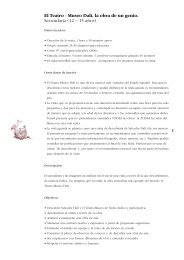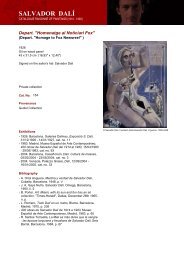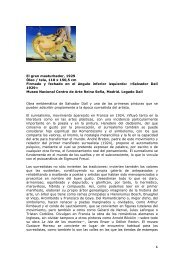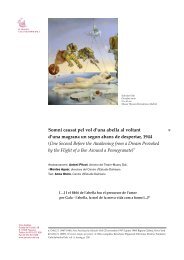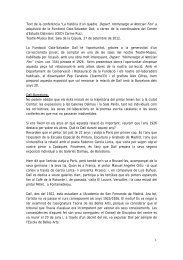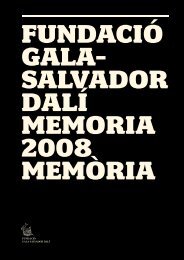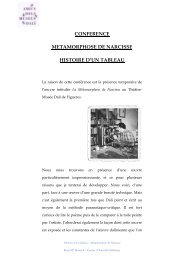INTRODUCTIONThanks to <strong>the</strong> Fundació Gala-Salvador Dalí’s policy <strong>of</strong> active cooperation with o<strong>the</strong>r institutionswhose collections include works <strong>by</strong> Salvador Dalí, visitors to <strong>the</strong> Dalí Theatre-Museum inFigueres have recently been able to see a number <strong>of</strong> <strong>the</strong> artist’s major pictures on temporaryloan, such as Metamorphosis <strong>of</strong> Narcissus and The Persistence <strong>of</strong> Memory. In 2010 we are pleased topresent <strong>the</strong> oil painting <strong>Dream</strong> <strong>Caused</strong> <strong>by</strong> <strong>the</strong> <strong>Flight</strong> <strong>of</strong> a <strong>Bee</strong> <strong>around</strong> a <strong>Pomegranate</strong> <strong>One</strong> Second BeforeAwakening, from 1944, generously loaned <strong>by</strong> <strong>the</strong> Thyssen-Bornemisza Museum in Madrid. Thework will be on show at <strong>the</strong> Dalí Theatre-Museum in Figueres, from 9 February to 2 May 2010.For <strong>the</strong> occasion, <strong>the</strong> Fundació Gala-Salvador Dalí has prepared a dossier and a number <strong>of</strong>informative materials in order to present and analyse a significant picture from Dalí’s oeuvre.1. WORKDescriptionWhen Gala described to Dalí <strong>the</strong> strange images she had seen in a dream that was somehowrelated to <strong>the</strong> flight <strong>of</strong> a bee <strong>around</strong> a pomegranate, <strong>the</strong> artist lost no time in painting <strong>Dream</strong><strong>Caused</strong> <strong>by</strong> <strong>the</strong> <strong>Flight</strong> <strong>of</strong> a <strong>Bee</strong> <strong>around</strong> a <strong>Pomegranate</strong> <strong>One</strong> Second Before Awakening, <strong>of</strong> 1944. 3 Thesetting for <strong>the</strong> picture is once again a landscape <strong>of</strong> Portlligat, which Gala shares with twopomegranates, a large scorpionfish, two tigers, a rifle with a bayonet, a bee and an elephant withlong, insect-like legs. All <strong>of</strong> <strong>the</strong>se elements, presented in a manner that could be regarded as acinematic sequence, are part <strong>of</strong> <strong>the</strong> dream <strong>of</strong> a voluptuous reclining Gala who seems obliviousto <strong>the</strong> strange events going on <strong>around</strong> her. The reading <strong>of</strong> <strong>the</strong> painting, as its title makes clear,starts with <strong>the</strong> bee hovering over <strong>the</strong> small pomegranate in <strong>the</strong> foreground. This pomegranate02is also <strong>the</strong> origin and source <strong>of</strong> Gala’s dream, depicted on <strong>the</strong> left side <strong>of</strong> <strong>the</strong> picture.Looking a little more closely, we see that none <strong>of</strong> <strong>the</strong> objects that appear in <strong>the</strong> picture istouching any <strong>of</strong> <strong>the</strong> o<strong>the</strong>rs: everything floats, everything hangs suspended. The dream-imageis <strong>the</strong> snapshot <strong>of</strong> a precise moment, frozen and perfectly painted <strong>by</strong> hand.The Context <strong>of</strong> <strong>the</strong> WorkDalí painted <strong>Dream</strong> <strong>Caused</strong> <strong>by</strong> <strong>the</strong> <strong>Flight</strong> <strong>of</strong> a <strong>Bee</strong>… at a time <strong>of</strong> historical impasse and a stylisticcrossroads: World War II was drawing to an end and a distinctively American art was emerging.The year was 1944: Dalí’s creativity was burgeoning, coinciding with <strong>the</strong> mid point in his stayin America (1940-1948). When Dalí arrived in <strong>the</strong> United States in 1940 he declared that hisintention was to become rich and famous. During his stay in <strong>the</strong> New World, Dalí consolidatedhis persona, involved himself in various projects (sets for <strong>the</strong> <strong>the</strong>atre, ballet and opera, filmscripts, illustrations for books, designs for jewellery and clo<strong>the</strong>s, photographic projects…)and socialized with rich and influential people, ensuring his social standing.3. TAYLOR, M. (2004). “<strong>Dream</strong> <strong>Caused</strong> <strong>by</strong> <strong>the</strong> <strong>Flight</strong> <strong>of</strong> a <strong>Bee</strong> <strong>around</strong> a <strong>Pomegranate</strong>, <strong>One</strong> Second beforeAwakening” In: Dalí, Bompiani, Milan, p. 334
Painting for <strong>the</strong> ballet Sentimental ColloquyPoster advertising <strong>the</strong> book Hidden FacesThe year 1944 was a very productive one for Dalí. He designed advertising images for <strong>the</strong>stocking manufacturer Bryans, for perfume, lipstick and o<strong>the</strong>r products for Elsa Schiaparelli,and for McCurrach ties; he contributed articles and illustrations to a number <strong>of</strong> magazines, andin June published his only novel, Hidden Faces. At <strong>the</strong> end <strong>of</strong> <strong>the</strong> summer he signed <strong>the</strong> contractthat resulted in his creating <strong>the</strong> dream sequence for Alfred Hitchcock’s film Spellbound, whichpremiered in 1945. During <strong>the</strong> last three months <strong>of</strong> 1944 he designed <strong>the</strong> sets for <strong>the</strong> stage playSentimental Colloquy and created <strong>the</strong> libretto, <strong>the</strong> costumes and <strong>the</strong> sets for <strong>the</strong> ballet Mad Tristan.2. SALVADOR DALÍThe Historical Context in Europe and <strong>the</strong> United States03With <strong>the</strong> outbreak <strong>of</strong> World War II, <strong>the</strong> art scene in both Europe and America underwent asudden drastic change, and among <strong>the</strong> artists who fled a Europe at war many sought refuge in<strong>the</strong> United States. This migration left Europe relatively bereft <strong>of</strong> artists while America gainedsignificantly in artistic importance. The new continent’s absorption <strong>of</strong> transatlantic émigréintellectuals coincided with <strong>the</strong> advent <strong>of</strong> a specifically American form <strong>of</strong> modern art: AbstractExpressionism. Dalí painted <strong>Dream</strong> <strong>Caused</strong> <strong>by</strong> <strong>the</strong> <strong>Flight</strong> <strong>of</strong> a <strong>Bee</strong>… at a time when <strong>the</strong> Surrealism<strong>of</strong> <strong>the</strong> exiled coexisted with <strong>the</strong> newly emerging Abstract Expressionism. This was a period <strong>of</strong>great upheaval in art, a moment <strong>of</strong> syn<strong>the</strong>sis between abstraction and surrealism, marked <strong>by</strong><strong>the</strong> emergence <strong>of</strong> what would come to be known as <strong>the</strong> New York School, whose prominentfigures included Mark Rothko, Jackson Pollock, William Baziotes and Robert Mo<strong>the</strong>rwell. Dalítook no part in this pictorial transition at <strong>the</strong> artistic level, in <strong>the</strong> sense that he was not a member<strong>of</strong> any movement and instead remained faithful to his own style. There was to be no stylisticbreak in his work, no move towards Abstract Expressionism; nor did he form strong personalties with any <strong>of</strong> <strong>the</strong> émigré artists. Maintaining his provocative, rebellious spirit, Dalí baptisedhis painting anew, calling for a return to classicism and turning to photographic realism. Aswe can see in <strong>Dream</strong> <strong>Caused</strong> <strong>by</strong> <strong>the</strong> <strong>Flight</strong> <strong>of</strong> a <strong>Bee</strong>… this was bound up with an evident pictorialpreciosity, and indeed Dalí described painting as ‘“photography” done <strong>by</strong> hand and in colours<strong>of</strong> <strong>the</strong> “concrete irrationality” and <strong>of</strong> <strong>the</strong> imaginative world in general’. 44. DALÍ, S. (1934), ‘The Latest Modes <strong>of</strong> Intellectual Stimulation for <strong>the</strong> Summer <strong>of</strong> 1934’. In: Finkelstein, H.The Collected Writings <strong>of</strong> Salvador Dalí, Cambridge University Press, 1998, p. 254


